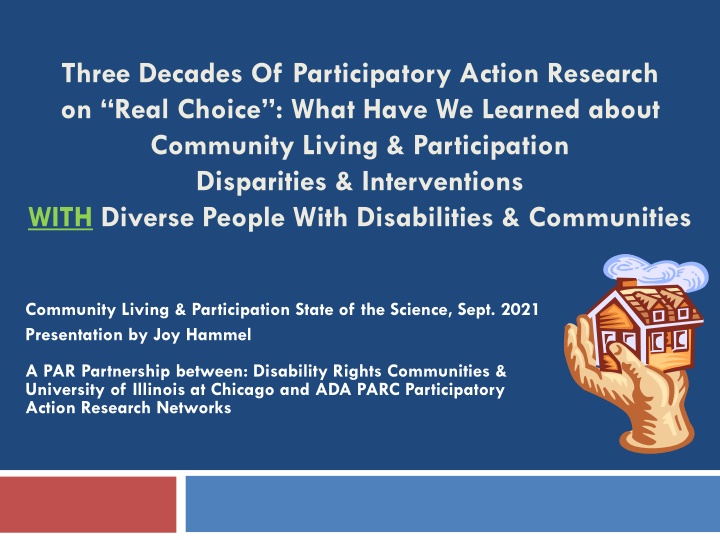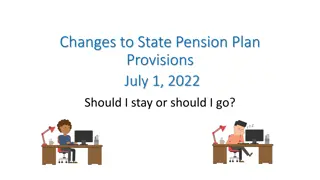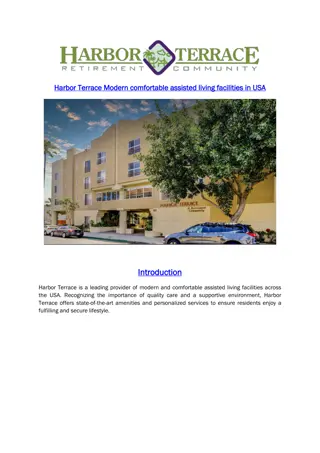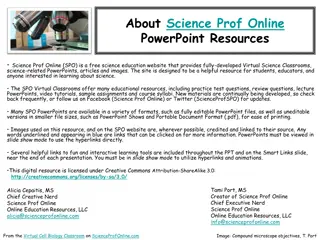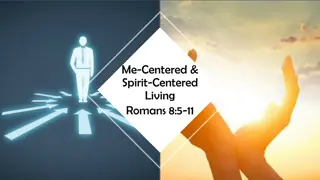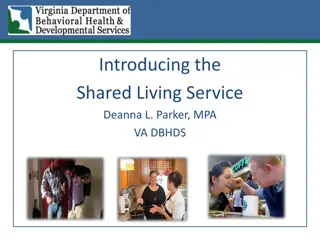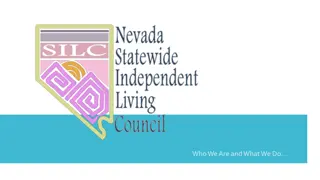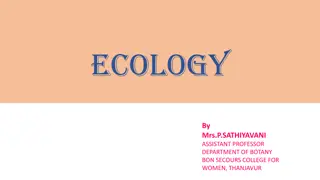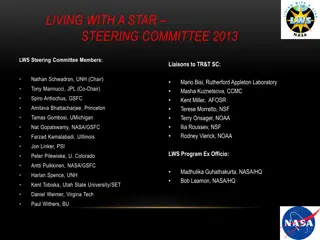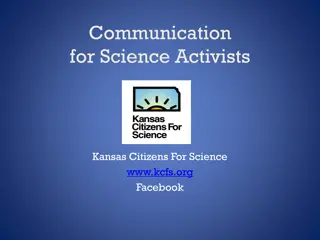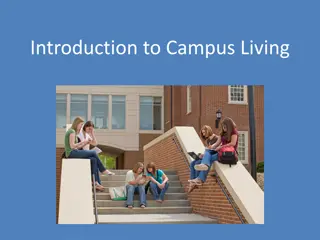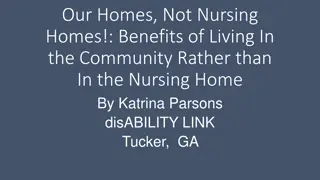Decades of Participatory Action Research on Community Living and Participation Disparities
Explore the insights gained from three decades of participatory action research on real choice, community living, and participation disparities among diverse people with disabilities. The initiatives focus on multifaceted interventions aimed at promoting community living and participation, with a specific emphasis on addressing disparities and inequitable access to services for marginalized groups.
Download Presentation

Please find below an Image/Link to download the presentation.
The content on the website is provided AS IS for your information and personal use only. It may not be sold, licensed, or shared on other websites without obtaining consent from the author.If you encounter any issues during the download, it is possible that the publisher has removed the file from their server.
You are allowed to download the files provided on this website for personal or commercial use, subject to the condition that they are used lawfully. All files are the property of their respective owners.
The content on the website is provided AS IS for your information and personal use only. It may not be sold, licensed, or shared on other websites without obtaining consent from the author.
E N D
Presentation Transcript
Three Decades Of Participatory Action Research on Real Choice : What Have We Learned about Community Living & Participation Disparities & Interventions WITH Diverse People With Disabilities & Communities Community Living & Participation State of the Science, Sept. 2021 Presentation by Joy Hammel A PAR Partnership between: Disability Rights Communities & University of Illinois at Chicago and ADA PARC Participatory Action Research Networks
Funding This research was funded by: National Institute on Disability, Independent Living and Rehabilitation Research (NIDILRR) Stepping Stones Field-initiated Research: #H133G0100383 RRTC on Aging with Developmental Disabilities: #H133B080009 RRTC on Promoting Integration for Stroke Survivors: Overcoming Societal Barriers: #H133B031127 Americans with Disabilities Act Participation Action Research Consortium DRRP: #90DP0026 and 90DPAD0001 State of Illinois Medicaid UIC Institutes Policy and Civic Engagement Race & Public Policy
Multifaceted Interventions on Community Living & Participation (CLP) Focused on people with disabilities trying to: move out of nursing homes and institutions, live in the community long term, and, prevent costly and unwanted future institutionalization Based on civil right to live and participate in communities of choice with supports ADA & Olmstead Medicaid home & community-based services and supports
Multifaceted Interventions on CLP-2 Especially focused on people who experience disparities and inequitable access to these rights, supports and services Living in poverty and qualifying for Medicaid HCBS Representing people who identify as Black, Latinx and from other underrepresented social groups and intersecting identities Cross disability groups and identities
Three Examples Stepping Stones project (RCT with n=140 + continued funding from Illinois Medicaid to >800) Cross disability ATLAS & PEP projects with People with IDD (RCT with n=75; community advocacy program with n=400) IPASS project with People with Stroke (RCT with n=140)
What do they share? Participatory Action Research approach with community as full partners in: defining community living and participation needs, issues, strategies, strengths and assets designing & delivering interventions acting on findings to change systems and build community capacity Rigorous qualitative, quantitative and action research methods and analyses Need a combo to impact systems and policy changes
PAR Process-1 Prior to intervention testing Community Action Team Design funded by grants Participatory Appreciative Inquiry focus groups co-led by community experts/peer mentor facilitators as paid members of research team Participatory community assessments and consumer directed goal setting & outcome reporting Consumer-directed assessments of CLP outcomes Community Participation Indicators (CPI) assessment Community Participation Self Efficacy assessment CMS QOL survey
PAR Process-2 During Intervention Testing Designed & Tested Multifaceted CLP intervention together Based on social model of disability, social ecological & social learning theories Co-facilitated by Community Peer Mentors & Disability Studies PAR researchers Individual Guided Discovery coupled with Group Social Learning Problem solving, confidence building, active & transformative learning Participants learn how to manage, advocate for and change environments, and increase access to civil rights as a collective community Focus on building community empowerment at same time as individual self advocacy and self determination
Examples: Improving Participation after Stroke Self Management Program (IPASS)
PAR Process-3 Moving to action during and after interventions Findings and outcomes summarized in accessible language and shared back with community Infographics, fact sheets, accessible community reports, video documentaries, social media Community Town Halls to action plan as a community and to get policy makers and other key stakeholders to understand issues and respond to them in public Long-term Systems Change to move programming to community delivery as part of HCBS Findings used in civil rights legislation and legal cases
Significant Findings Improved CLP choice & control Improved CLP goal attainment Improved CLP engagement & satisfaction E.g., being able to do what you want or need to What, when and with whom Improved community enfranchisement E.g., equitable access to opportunity and resources, choice & control, community membership & social networking, voice, freedom, respect & dignity Improved physical and mental health management
Where are we headed? Large scale complex, tailored intervention testing embedded in a strong PAR community approach Long term systems and policy changes with disability rights communities Documenting and acting on social justice participation disparities nationally in ADA PARC at adaparc.org Community Living Community Participation Economic Equity
Much thanks to The many communities of learning, activism & action research collaborating and guiding us across local, state and national levels The many people with disabilities holding us accountable, supporting each other, and taking action to make the change happen For more information and access to references and resources from this PAR collaboration, contact Joy Hammel at hammel@uic.edu
